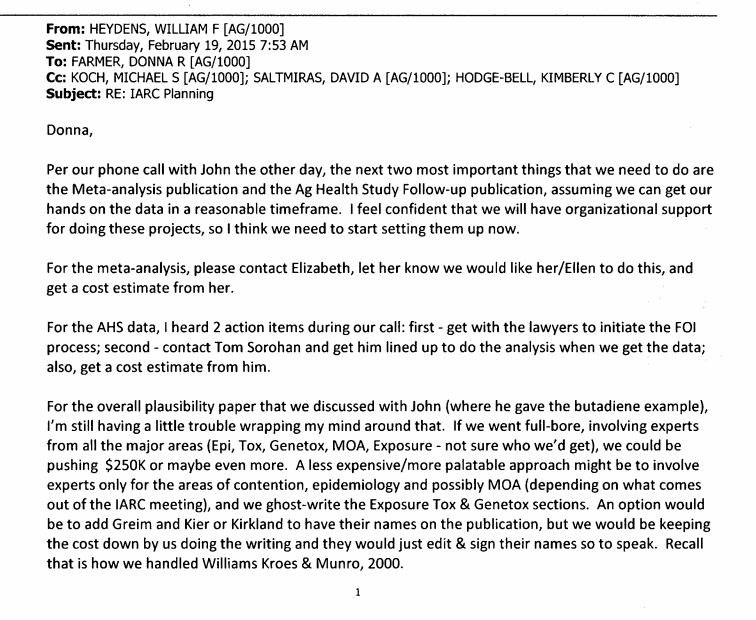(Transcript from today’s proceedings)
Following Tuesdays’ jury finding that Roundup use caused plaintiff Edwin Hardeman’s cancer, the second phase of Hardeman V. Monsanto began this morning in California with a shift away from the scientific evidence and on to allegations that Monsanto has spent years suppressing information about the dangers of its glyphosate-based herbicides.
While Hardeman’s lead counsel Aimee Wagstaff was sanctioned in the first phase for barely giving a nod to such claims, in the second phase the focus is squarely on Monsanto’s conduct in studying, manufacturing and selling its popular Roundup products.
“Roundup has been Monsanto’s billion-dollar baby for decades,” Wagstaff said in an interview Wednesday morning.”The evidence demonstrates Monsanto was far more interested in protecting its bottom line or Roundup’s continued sales than making sure the product was safe. In the meantime, people like Mr. Hardeman got cancer and are dying. We are confident the jury will do the right thing in phase two and send Monsanto a message it needs to hear.”
The jury verdict finding Roundup causes cancer is the second such jury determination in seven months, and indicates Bayer, which purchased Monsanto last summer, has a hard road ahead defending against thousands of plaintiffs who all claim exposure to Monsanto’s glyphosate-based herbicides caused their cancers. Another trial gets underway next week in Oakland, California.
Bayer shares fell more than 12% in early trading Wednesday after the jury’s determination that Roundup was a “substantial factor” in causing Hardeman’s cancer.
Judge Vince Chhabria plans to continue to keep a tight rein on what the jury will be allowed to hear, however. He generally has agreed with requests from Monsanto to prohibit evidence about Monsanto’s actions after 2012, the year Hardeman stopped using Roundup. The rationale is that the company’s actions after the plaintiff stopped using the product have no bearing on Hardeman’s development of non-Hodgkin lymphoma.
Plaintiff’s attorneys argued that there are many internal Monsanto emails dated after 2012 that illustrate a pattern of behavior, showing how the company has long worked to ghostwrite scientific papers, manipulate regulators and attack and silence critics. That evidence is critical to establishing Monsanto’s liability and damages, the plaintiff’s attorneys have told Chhabria.
In a discussion Tuesday about the evidence for the second phase, the judge indicated he sees a middle ground, saying “conduct that occurred post-2012 that sheds light on what was happening pre-2012 should generally be admissible, potentially subject to a limiting instruction if Monsanto wants it.” But he also said this: “Even if post-2012 conduct sheds light on what was happening pre-2012, there may be other reasons to exclude it.”
Notably, the judge is barring evidence about Monsanto’s efforts to discredit the International Agency for Research on Cancer, which in 2015 classified glyphosate as a probable human carcinogen. Monsanto spent millions of dollars on various secretive tactics aimed at discrediting IARC. Documents that have come to light through discovery show the company discussing using third parties who appeared to be independent of Monsanto to publicly criticize IARC and push Monsanto propaganda points. The internal Monsanto records show the company’s role in ghostwriting an article that appeared on Forbes’ contributors’ platform, and they show that the company was behind a story published by Reuters in 2017 that falsely claimed an IARC scientist withheld information from IARC that would have changed the classification.
The judge is also barring evidence about how Monsanto worked to discredit French scientist Gilles-Éric Séralini after publication of his 2012 study findings about rats fed water dosed with Roundup. Internal Monsanto records show a coordinated effort to get the Seralini paper retracted, including this email string.
Monsanto employees apparently were so proud of what they called a “multimedia event that was designed for maximum negative publicity” against Seralini that they designated it as an “achievement” worth recognition.
The plaintiff’s attorneys will also not be able to introduce evidence of Monsanto’s efforts to kill a toxicity review of glyphosate by the Agency for Toxic Substances and Disease Registry.
The judge is allowing portions of a 2015 internal Monsanto email in which company scientist Bill Heydens discusses plans to ghostwrite a series of new scientific papers that will contradict IARC’s classification of glyphosate because in that email, Heydens remarks on how this plan is similar to the ghostwriting of a scientific paper published in 2000 that found glyphosate to be safe.
See all updates at Trial Tracker blog.










